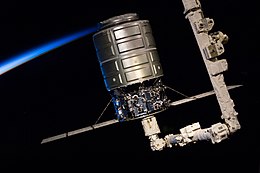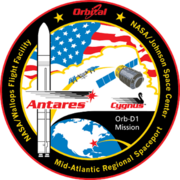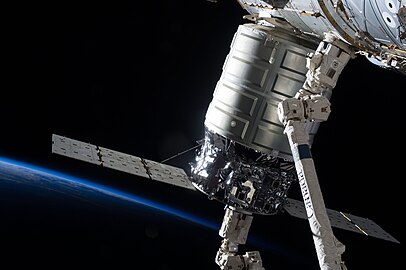 Canadarm2 grapples the S.S. G. David Low | |
| Mission type | |
|---|---|
| Operator | Orbital Sciences Corporation |
| COSPAR ID | 2013-051A |
| SATCAT no. | 39258 |
| Mission duration | 35 days, 3 hours, 17 minutes |
| Spacecraft properties | |
| Spacecraft | S.S. G. David Low |
| Spacecraft type | Standard Cygnus [1] |
| Manufacturer |
|
| Launch mass | 4,127 kg (9,098 lb) [2] |
| Payload mass | 700 kg (1,500 lb) [3] |
| Start of mission | |
| Launch date | 18 September 2013, 14:58:02 UTC (10:58:02 am EDT) [4] |
| Rocket | Antares 110 [1] |
| Launch site | MARS, Pad 0A |
| End of mission | |
| Disposal | Deorbited |
| Decay date | 23 October 2013, 18:16 UTC |
| Orbital parameters | |
| Reference system | Geocentric orbit [5] |
| Regime | Low Earth orbit |
| Inclination | 51.65° |
| Berthing at ISS | |
| Berthing port | Harmony nadir |
| RMS capture | 29 September 2013, 11:00 UTC |
| Berthing date | 29 September 2013, 12:44 UTC |
| Unberthing date | 22 October 2013, 10:04 UTC |
| RMS release | 22 October 2013, 11:31 UTC |
| Time berthed | 22 days, 21 hours, 20 minutes |
 Orbital mission patch | |
Orbital-D1, [6] also known as Orb-D1, [7] [8] and Cygnus 1, [9] was the first flight of the Cygnus cargo spacecraft developed by Orbital Sciences Corporation. It was named after the late NASA astronaut and Orbital Sciences executive G. David Low. The flight was carried out by Orbital Sciences under contract to NASA as Cygnus' demonstration mission in the Commercial Orbital Transportation Services (COTS) program. The mission launched on 18 September 2013 at 14:58:02 UTC. Cygnus was the seventh type of spacecraft to visit the International Space Station (ISS), after the crewed Soyuz and Space Shuttle, and uncrewed Progress, ATV, HTV and Dragon 1.




